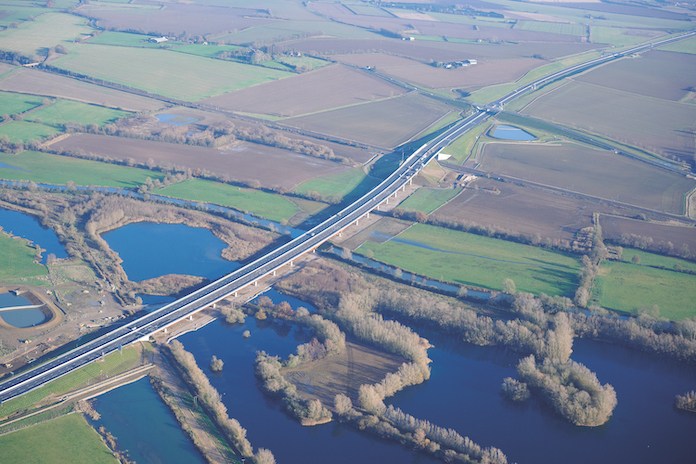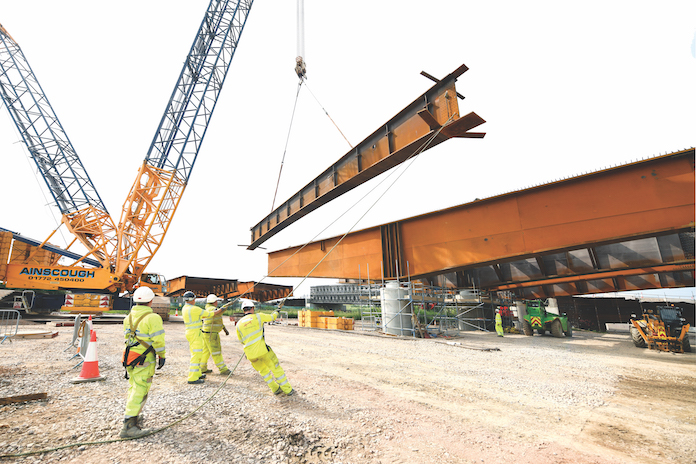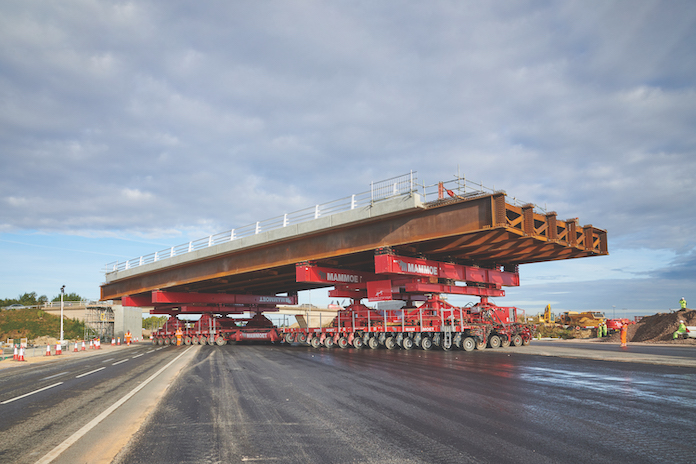
The River Great Ouse Viaduct required 6,000 tonnes of steel (Credit: James Walker)
Steelwork proved to be the ideal material to construct the longest bridges on a major £1.5bn road improvement scheme
Opened earlier this year, Highways England’s £1.5bn A14 improvement scheme between Cambridge and Huntingdon is said to have relieved congestion, unlocked economic growth, improved safety and enhanced the local environment.
There are numerous bridge structures along the route of the scheme including the scheme’s showpiece bridge, a 750m-long viaduct over the River Great Ouse, and two identical 1,050-tonne bridges to carry a major roundabout at Bar Hill Junction over the new A14.
Weathering steel was used for all three structures to provide the required durability with minimal future maintenance.
The River Great Ouse viaduct required 6,000 tonnes of steel, comprising 76 separate main girders and 800 cross girders. The ladder deck bridge spans the river itself and a large area of floodplain on either side.
Supported on 16 pairs of piers, most of the main girders required were 40m long, 2m deep and weighed 50 tonnes. The section of bridge that crosses the river has a longer span requiring more complex girders, with larger, deeper haunches to carry the greater load.

Credit: James Walker
A time-saving construction method adopted on this viaduct was the use of precast concrete slabs for the deck rather than the more traditional insitu concrete deck slab. This meant that the concrete deck units could be installed simultaneously while steelwork erection was still in progress further along the bridge.
This construction sequence demanded close coordination and also meant that every piece of steelwork had to be fabricated to extremely tight tolerances to ensure a precise interface with the precast concrete slabs.
The viaduct was completed on budget and ahead of schedule.
The installation of the twin bridges at Bar Hill Junction over the new A14 maximised the advantages of offsite steel fabrication and rapid assembly to improve programme times, reduce environmental impacts and minimise disruption to road users.
The multi-girder bridge decks, each measuring 47.5m in length comprise three pairs of braced main girders supporting GRP permanent formwork and an insitu concrete deck slab. Overall, each deck contains 330 tonnes of steel and 720 tonnes of concrete.

One of the Bar Hill Junction bridges is manoeuvred by self-propelled modular transporters (SPMT) (Photo credit: James Walker)
The original plan was to erect the bridges piece-by-piece using a crane. This would have involved closing the A14 for a number of weekends, causing significant disruption. However, a more cost-effective scheme was developed that allowed both bridges to be constructed offline prior to installation, and then installed using self-propelled modular transporters (SPMTs).
The A14 was closed to traffic at 9pm on a Friday to allow the sections of the existing A14 carriageway to be infilled and surfaced. The fully concreted bridge decks were then lifted from the trestles onto the SPMTs, and manoeuvred at less than 1mph onto and along the carriageway. The decks were positioned by the SPMTs and lowered precisely onto the concrete abutments.
Both bridges were installed during a single 11-hour period and the road was clear for reopening at noon on Sunday, an incredible 18 hours ahead of schedule
The judges were impressed with the innovative solutions the project team employed to minimise disruption, optimise the programme and ensure flawless execution on site.
- Award: A14 Cambridge to Huntingdon Improvement Scheme
- Structural engineer: Atkins, CH2M Hill Joint Venture
- Steelwork contractor: Cleveland Bridge
- Main contractor: A14 Integrated Delivery Team
- Client: Highways England











